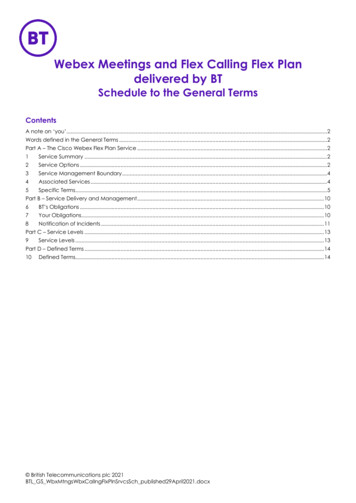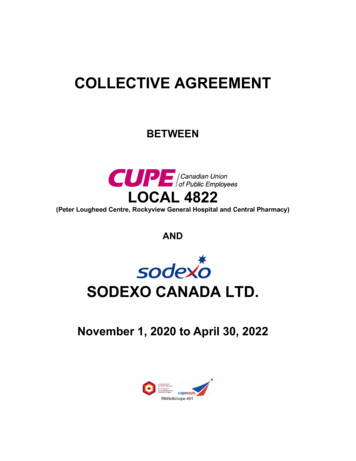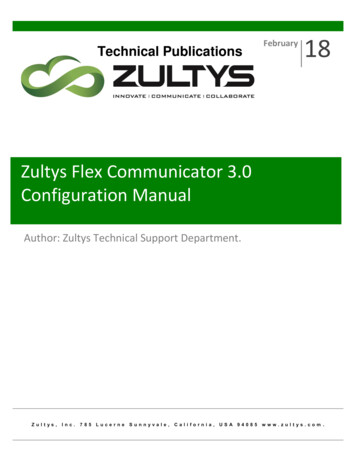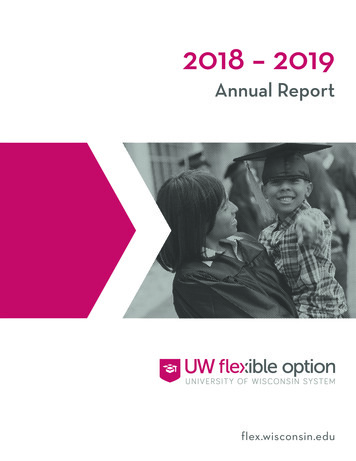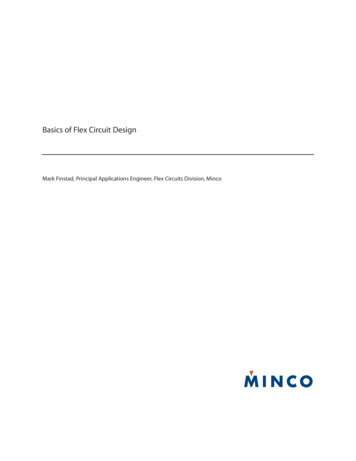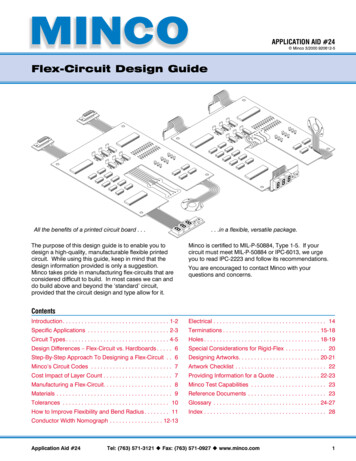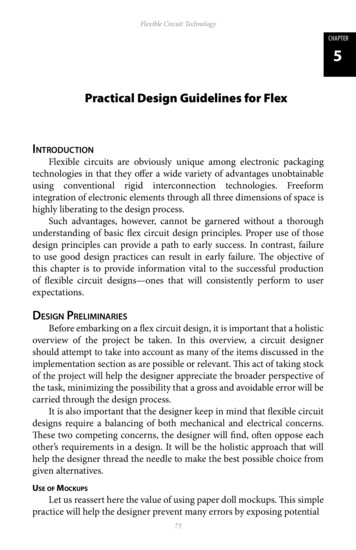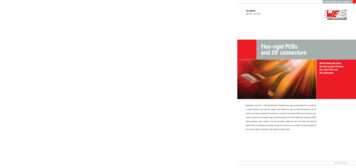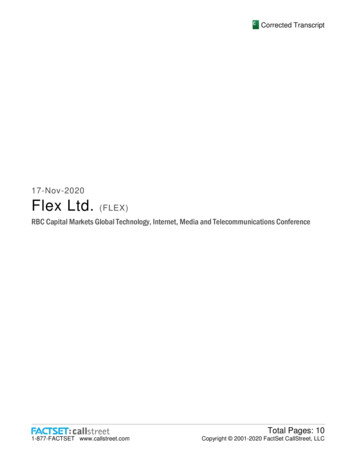
Transcription
Corrected Transcript17-Nov-2020Flex Ltd.(FLEX)RBC Capital Markets Global Technology, Internet, Media and Telecommunications ConferenceTotal Pages: 101-877-FACTSET www.callstreet.comCopyright 2001-2020 FactSet CallStreet, LLC
Flex Ltd. (FLEX)RBC Capital Markets Global Technology, Internet, Media and TelecommunicationsConferenceCorrected Transcript17-Nov-2020CORPORATE PARTICIPANTSPaul R. LundstromChief Financial Officer, Flex Ltd.OTHER PARTICIPANTSRobert MullerAnalyst, RBC Capital Markets LLC.MANAGEMENT DISCUSSION SECTIONRobert MullerAnalyst, RBC Capital Markets LLCHey. Good morning, everyone. I'm Rob Muller. I'm the enterprise hardware analyst here at RBC. I'm happy tohave Paul Lundstrom, Chief Financial Officer of Flex, newly appointed. Welcome. Paul, do you want to just give aquick hello and then we can jump right into Q&A.Paul R. LundstromChief Financial Officer, Flex Ltd.Yeah. Happy to do that. Thanks, Rob, for having us. Really appreciate it. Yeah. My name is Paul Lundstrom. I'mthe new CFO of Flex. I also have with me – I think able to speak anyway. They might not be on camera, but DavidRubin and Katherine Chen who run our Investor Relations organization.21-877-FACTSET www.callstreet.comCopyright 2001-2020 FactSet CallStreet, LLC
Flex Ltd. (FLEX)RBC Capital Markets Global Technology, Internet, Media and TelecommunicationsConferenceCorrected Transcript17-Nov-2020QUESTION AND ANSWER SECTIONRobert MullerAnalyst, RBC Capital Markets LLCQGreat. Thank you. So I'll just jump right into the topic of the day or I should say the past few weeks with you, a lotof interest in your Nextracker business following a recent IPO of a competitor. Could you just give us a little bit ofan overview on the Nextracker business, revenue opportunity, what are some growth rates that would bereasonable, can you discuss the margin profile, just as well as the industry at large?.Paul R. LundstromChief Financial Officer, Flex Ltd.AYeah, sure. Happy to do that. And you're right there – given recent events over the last few weeks, for somereason, there is a pretty intense interest on our Nextracker business. So maybe just a little bit about the businessitself before we get into it.We invested in a company called Nextracker a number of years ago. It's a solar tracker business. And what asolar tracker business does – brilliant concept, really simple like most brilliant ideas. As the sun goes through thesky throughout the day, we have Nextracker, builds a system that adjusts the pitch of the panel as the sun movesthrough the sky with the goal of maximizing the energy output of the solar field, maximize the sun's exposure tothe panel. You're going to maximize electricity generation and it's going to make the field – the solar field asproductive as possible. It's great for the operator of the asset because, again, you generate max energy.Great concept. It's been around for a while. The Nextracker business has been a very good business within theFlex portfolio. You probably heard us talk during the earnings call, sort of size the business, and I'm not going togive incremental disclosure on that today. But just as a reminder, it is a business north of the 1 billion top line,generates double-digit margin rates. And the business, it's number one in the space. We are the market leader.There's a fair amount of publicly available data out there that I think people can do some work on. Look, very, verylarge installed base. We're the market leader in terms of gigawatts installed. Great, great business.We like that people have recognized the value of the asset. I think that's good news. And what I – if there's onetakeaway I would want investors to get, it would be this: as this team has done over the last year and a half or so,this team has demonstrated that we will aggressively manage the portfolio to maximize shareholder value. And sothis particular situation is definitely a priority for us.Robert MullerAnalyst, RBC Capital Markets LLCQGreat. And on that, can you just walk us through a little bit more on your thought process as it would relate topotential portfolio optimization? Any hurdles that you have? And we do have a Q&A. I'll paraphrase it butsomeone asking if a split-off of Nextracker spinout would be kind of the highest return project I guess, and I'mparaphrasing the Q&A there. Maybe if you can just walk us through sort of your thoughts on how that fits in theportfolio.Paul R. LundstromChief Financial Officer, Flex Ltd.A31-877-FACTSET www.callstreet.comCopyright 2001-2020 FactSet CallStreet, LLC
Flex Ltd. (FLEX)RBC Capital Markets Global Technology, Internet, Media and TelecommunicationsConferenceCorrected Transcript17-Nov-2020Yeah. So I'm not going to address that one specifically. But let me just talk to you a little bit about process. So Ithink process is the perfect word for it, Rob. My view is that portfolio review is not episodic. It's not something thatyou do every two or three years. It's got to be a process of constantly reevaluating all the assets in your portfolio.And you've heard Revathi talk since she came to the company about mix and constantly evaluating and improvingthe mix of the business. Part of that's portfolio review. You look back over the last year and a half or so, we'vepulled out of maybe a 1 billion worth of businesses that were shorter cycle, lower mix businesses. And so that tome, that's pruning.Sometimes portfolio review is going the other way. It's maybe not shedding things. Maybe you're finding otherways to maximize the value for things. And it's not just getting out of businesses. It's investing in businesses. Ithink we have a lot of balance sheet capability to do other investments in the Flex portfolio whether it's things togrow organically, whether it's more R&D spend or CapEx or whether it's inorganic avenues like M&A. I think we'vegot a lot of options on our plate right now, which is a great place to be. Again it's going to be a process. We'regoing to continue to review the portfolio. We're going to look at all ways to maximize the value for ourshareholders. I think we're in a really good place right now, Rob.Robert MullerAnalyst, RBC Capital Markets LLCQGreat. And then you did touch on this a little bit just now, but over the last year, you have exited less profitablebusiness lines. Is there a desire to continue to prune further or are you happy with your current mix? And thenyou're also coming in with a fresh set of eyes, right? So anything that you've been looking at, anything that hasjumped out of, maybe we should get stronger in this area or continue to prune further?.Paul R. LundstromChief Financial Officer, Flex Ltd.AYeah. So, yeah. So you're absolutely right. And as I said, a 1 billion business or so is what we've pulled out ofover the last year or two. The way we see it as of this moment, no more heavy lifting to do. But as I said before,my view and the whole team's view really is portfolio review is a process. It's not something that you do onceevery few years. We will continually reevaluate business lines that we have. And so, although I'm saying no heavylifting today, I reserve the right to change my mind. We could move down the road and say we need to makesome adjustments.And case in point, you can have a customer or a business line that's a fantastic business. And there's someexogenous change in the marketplace, whether it's a different competitor or if it's a changing market condition,and a great contract can convert from a great contract to a terrible contract. And at that point, you have to pivotand you have to be fleet enough – fleet of foot enough to recognize the need to pivot, hence my comment onprocess. Evaluating the mix and getting into details of all your different business lines, that has to be a processthat you continually move through, so that again, we're doing the best thing for our shareholders long term, andsometimes that means pruning.Robert MullerAnalyst, RBC Capital Markets LLCQGreat. Thank you. And so with exiting out of less profitable businesses, focused investments, some higher marginareas, what do you see as your long-term operating margin potential and what do you think are going to be reallythe key drivers of success or failure when it comes to achieving these metrics?.41-877-FACTSET www.callstreet.comCopyright 2001-2020 FactSet CallStreet, LLC
Flex Ltd. (FLEX)RBC Capital Markets Global Technology, Internet, Media and TelecommunicationsConferencePaul R. LundstromChief Financial Officer, Flex Ltd.Corrected Transcript17-Nov-2020AYeah. Love the question, and I'll tell you this. So relatively new at the company and within the last couple ofmonths, but the process started this summer and as I was doing my own work on Flex, I'll – let me put it to youthis way, Rob. If Flex had been a 15% up margin business and a 75 stock, I wouldn't have signed on. I see thisas a business that has a lot more runway when it comes to margin and margin rates. And you go back to some ofthe comments that the leadership team made at the Investor Day we had back this spring, whenever it was, eight,nine months ago. We talked about mid-single-digit op margins. Well, look, we just did 4.1% in Q2. And so, we hitthe low end of that range. My personal view is, yeah, absolutely mid-single digits, but mid-single digit could be 4%and it could be 6%. And are we going to stop at 4%? Absolutely not. Are you kidding me?And when it comes specifically to margins and margin expansion, I think there's a lot of things that we need tofocus on. And these are things that I've seen focused on and other companies I've been with, with tremendoussuccess, by the way. One is, what we talked about already and that's constantly managing the mix of thebusiness. It's a process, not an episode. Constantly, have to review that. So that's one. Second one would beprice. We need to make sure that we're getting max value for the value that we provide. And if you look customerby customer, sometimes that's the case and sometimes it's not. And so, what is our pricing discipline? That's apotential lever for us. And then, three more which are all sort of cost related. One would be, I've been in longcontract – long-term contract businesses my whole career.And I can tell you Rob, you do a Pareto, high to low of long-term contracts, there's always going to be somewinners and there's always going to be some losers. Every single business has the same issue. The question ishow do you minimize the fallout from the bad contracts. And unfortunately, what I've seen over the years is theselarger contracts tend to have 10 million issues. It's never 2 million. It's always 10 million or 20 million. And solook at a business like Flex, and I'm not saying we've had these, but I'm sure over time, we have. These thingshappen. Like I said, 10 million, 20 million, 30 million chunks. If we could just get rid of 50 million with the badstuff on a run rate basis, that's 20 basis points of margin expansion just like that.And so eliminating execution issues on large contracts, definitely a priority. And then the last two on the cost side,Rob, would be, we have an overhead structure and we have a factory footprint. I think we've done a pretty nicejob managing both. However, it's a target-rich environment. We have a tremendous footprint being a company oursize. We operate in 30 different countries. We've got 120-plus manufacturing facilities. We've got 44 millionsquare feet of factory space. That's a lot. And so to say, there's not room sort of on the margins to tweak somethings here and there and constantly go through the process of evaluating our facilities costs and making surethat it's optimized definitely is another lever for us, and then the overhead as well.So I think there are a number of levers for us to drive margin expansion. That's absolutely going to be a focus ofmine as we move through the next few years. And so maybe short answer to your question on margins. What'sthe potential? Mid-single digit for sure. But I don't think we want to stop there.Robert MullerAnalyst, RBC Capital Markets LLCQGot you. And so let's say you increase your margin profile, at that point, theoretically, you have some higher freecash flow along those lines. Recently, you reinstated your share buyback. So I was just hoping could you justremind us of your capital allocation strategy going forward? What's the size of the buyback and how are you goingto try and balance buybacks versus other uses of capital and really what's going to be your thought processbehind that?51-877-FACTSET www.callstreet.comCopyright 2001-2020 FactSet CallStreet, LLC
Flex Ltd. (FLEX)RBC Capital Markets Global Technology, Internet, Media and TelecommunicationsConferencePaul R. LundstromChief Financial Officer, Flex Ltd.Corrected Transcript17-Nov-2020ASo I love the way you set up that question, Rob, and it's validating because I literally just had a meeting with anumber of our teammates internally yesterday, and I said the exact same thing. As your margin profile comes up,as you generate more free cash flow, it turns into a flywheel and you have so many more options being abusiness that's thrown off more cash. You've got more – it's optionality and more arrows in your quiver. So can wedo more capital return? Yes. Can we do more investment in inorganic opportunities through M&A? Also yes. Doyou create more opportunities for internal investment for things like R&D and CapEx? Yes.So maybe to address your question there specifically, we're going to keep an open mind. We're not going to betoo prescriptive on a framework right now. [ph] Share re (00:12:54) is definitely something that we're going to startdipping our toe in here again. I mean, we've talked about that on the Q2 earnings call. We had turned off theprogram rightfully so, as things were really getting dicey with the coronavirus pandemic. But the [ph] share re(00:13:10) program is back on. We're going to crawl, walk, run, I guess is the way I would say we'll approach that.M&A is an arrow in our quiver. Internal investment is an arrow in our quiver. I think a balanced approach to capitalallocation is my view sort of as we stand today, and we'll tweak that as we go forward depending on theopportunity set and overall market conditions for everything.Robert MullerAnalyst, RBC Capital Markets LLCQGreat. And amazingly, I think we went 14 minutes without bringing up coronavirus which might be a record givenwhat's going on this year. So, I would love to just kind of touch on that a little bit. Multiple countries in Europepotentially are walking down second wave considerations, concerns about what might happen in the US. You'vealso got Asian manufacturing as well. So if there is a increased wave above what we're seeing now and plants areforced to shut down, and you're forced to operate with limited employees or space constraints, what steps canyou take to limit this impact, and how might this sort of affect your operations and your outlook for the comingwinter months?.Paul R. LundstromChief Financial Officer, Flex Ltd.AYeah. So maybe I'll answer that, Rob, in two parts. First part is just on the demand side. So, we gave guidance in– at the end of the Q2 earnings call on Q3. We talked about some continued sequential improvement. I believewe've seen no major impact thus far on the demand side. It seems like everything's tracking. So I think that'sgood. I will say it is a little concerning when you see case rates growing as substantially as they have been inEurope. You're seeing some case comes up in the US as well. Some states are going back and California justchanged their mind and now we're back to stage purple, whatever that means. So a little bit of – maybe it's awatch item from the demand side but, thus far, I would say no major impact. Internally, I have to give credit to theteam. I mean all this is well before my time. They've done a really nice job managing safety and making sure thatemployee health was priority number one. And it's a credit to the team on that.We're doing all the things that high-quality companies are. Obviously, we're social distancing and we're putting upplastic barriers between work stations. And we've got masks and mandatory health checks on the way intofacilities. Here's a data point for you. We've done 24 million temperature checks for our facilities around the world,24 million. And also interestingly, we've turned people away and that number measures in the thousands. And soyou think about the effect that potentially has on an operations sort of being firm on admittance into your facility,that's great and that's what we have to keep doing. And so, I don't think we're going to have a significant impact. It61-877-FACTSET www.callstreet.comCopyright 2001-2020
Flex Ltd. (FLEX)RBC Capital Markets Global Technology, Internet, Media and Telecommunications Conference Correcte
